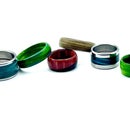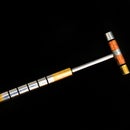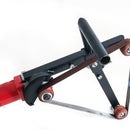Introduction: DIY Metal Project: Buckthorn / Shrub Small Tree Puller Remover
They do make commercially available products for this, but they're not common (not going to find one at home depot, let's say) and they're also very expensive. Like 20 times the cost I made mine for. That's why I've made two at this point.
Buckthorn is a nasty invasive species that fundamentally overtakes your backyard if it's in the area. My wife and I purchased a house (built in the late 1970's) in 2018 and the previous owners had basically let everything grow unchecked for nearly forty years. We had buckthorn covering an entire acre. It's not as simple as cutting it down as it will just grow back. Glyphosphate (roundup) doesn't work on it very well, and we don't want to kill everything else it's by. The best way is yanking it out by the roots. If that's not possible - much too large - we cut it down with a chain saw in the fall and spray roundup directly on the fresh stump. This is the ONLY way to ensure that the tree will not come back. With lots of little trees, that's not really feasible. That's where the puller comes in handy - yanks those adolescent buckthorns that are too hard to pull by hand and too small and tedious to cut with saws. We're in year 4 of removal - it's going well, but still more to be done before it can fully be eradicated. Whatever causes this devil's plant to prosper is strong, very strong. Be prepared for muliple years, or even a decade to eradicate this tree without drastic measures (like using bulldozers to remove the entire foot or so of topsoil and burning everything in it).
I made the original buckthorn puller four years ago until I finally snapped a metal piece attempting to pull a tree that would not budge. This one is modified / updated and made simpler than the previous. Assuming you make it out of adequate material and weld appropriately, it shouldn't break.
It is important to note, you don't have to follow my design. It's really astonishing how many ways this could potentially be made. Use your ingenuity based upon the materials you can get and make something completely your own.
Supplies
You'll need skills in addition to physical tools. But, if you have those tools, you probably have the skills or are just looking for a project to hone those skills.
Definite must haves:
1) A welder of any kind, capable of welding 1/8" thick steel up to 1/4" steel. Arc welders work fine. Tig is just fine. Mig / Wire Feed is just fine.
2) A drill press of some kind. You'll need to drill holes somewhat accurately perpendicular to the face of your material. You may be able to get around this with a hand drill, but it's less than ideal.
3) You must have a way to cut metal. I'm quite fond of my little horizontal band saw. It cuts Steel, stainless, aluminum, wood, etc - basically anything that isn't hardened. You can use a chop saw, which can cut through even hardened steel. However, they're very messy, can't cut aluminum, and very noisy. There are also cold cut saws made for metal, but honestly I prefer a horizontal bandsaw. Cold cut saws are quicker, but the blades are massively expensive. I'd rather pay $15 per bandsaw blade which lasts months versus a cold cut saw which can dull the first time you try and cut something it's not meant to. I just put a weight on the end of the saw handle and walk away to do something else while it's cutting, so time really isn't much of an issue. For Flat stock, you can use a hacksaw, or a metal abrasive cutoff wheel in an angle grinder (be aware of safety concerns - they're nasty little things that like to bite, and I have the stitches to prove it.)
4) An angle grinder with an abrasive flap wheel (heavy grit), a wire wheel for the grinder, and probably some abrasive cut off discs. Most grinders are 4-1/2" and can be purchased for as little as $20.
You'll need metal. For my project, I had some 11 gauge steel tubing with a 1.9" OD, 1.66" OD. I used 2.5" square tubing with a massive 1/4" wall that'll basically outlast my life on earth. I used 1.5" cold rolled round stock. I used some 1/2" I.D. steel pipe meant for air/gas lines that's available at basically any hardware store. I had some leftover chainlink fence posts that served for portions of the puller as well. I also used 1/8" (11 gauge flat stock) and 1/4" flat stock.
I live in Minnesota, not too far from Minneapolis. I go to my favorite metal store - Coremark metals. They have your regular selection of all kinds of metals and lots of metal odds and ends in various shapes to save you a lot of time having to cut something to a shape when you can already buy it in the shape you want. Sometimes you'll have to be creative, alter the design to fit what you can actually get your hands on. There are lots of ways to make this device, and don't feel restrained by having to make something exactly the same as mine. You're smarter than you think, and designing something entirely different isn't really all that difficult.
Step 1: Make the Main Body
The main body is the heart of the unit. None of it moves in relation to anything else - just a very rigid, static foundation from which the moving parts operate. Please note: if it's a cylindrical object, it's shown in the drawing as a 2d representation - just a ultra thin cross section shown, and revolved around an axis to form the cylindrical object - I show the picture of it after it's revolution for clarification.
It consists of 7 or so parts -
1) The main structure, which was 2.5" square tubing with a 1/4" wall thickness. I used about 12" of the material. You'll need to cut three pieces to make this. Please refer to the CAD design images and the video. It gets a hole drilled through it to accept part #3 of the main body.
2) the face plate. This is what the tree will be pressed into. I used 1/4" flat stock to make it. It's a 3.5" square piece of metal that's welded to the face of part 1 of the main body. Also, I used .25" x .25" steel for traction teeth to grab onto the tree - this is welded directly to the face plate.
3) The handle axle. I made this out of 1.5" cold rolled solid steel round stock. You could use pipe as well. It just has to be very sturdy. This
4) The base that touches the ground. This part is super simple - I welded just some old pipe to the base, and this serves as a good "snowshoe" to keep the puller from just sinking into the dirt as you use it. I didn't include it in the drawing, it's that simple. Use anything that's wide, has some amount of surface area, and is rigid. It doesn't have to be very fancy.
5) The foot - This is to keep the head of the unit from digging into the dirt as you open and close the jaws. Again, nothing fancy. I just used some pipe and a small piece of 1" square tubing. Again this isn't in the drawing, as it's really simple and you can use anything you have laying around.
6) The compressor assembly guide. This is probably the most complex part of it, but you can use your imagination to make anything that accomplishes the same task. Mine was a .5" wide piece of 2.5" square tubing with two pieces 1/8" flat stock welded to it. I drilled holes into it for the compressor pipe to fit into.
7) Handle Stop. This is just a 5/8" round stock cut 1" long that's welded onto the main body (part #1). This limits the handle from traveling too far in it's rotation.
Step 2: Make the Handle
The handle consists of a few parts:
1) female bit of pipe that slides over the handle axle from the main body. I made the inside 1.45" in diameter, and 1.9" for an outside diameter. It's 2.5" long.
2) The long handle - it's 36" long, give or take, with a notch to accept part #1of the handle. Parts 1 and 2 of the handle are welded together. There's also a hole drilled 1" from the top for part #3. There are two notches cut near the base to accept the #4 parts of this step. I made them 1/4" deep, and 1.23" wide. This is so I could weld (securely) flat stock to something round. I used a mill to accomplish this step, but you could potentially use a cut off wheel, hacksaw, a file, etc to make these.
3) The handle's handle. This is just a bit of .5" plumbing pipe with an OD of .8" that goes through the top of the handle. It's about a foot long. This gets welded to part #2.
4) Linkage part plates. I made these out 1/4" flat stock with a whole drilled in each. I used 16mm (5/8") bolts to go between the handle and linkage part. As such, the holes to be drilled were 5/8" (.625), but in my case, .627" since i used 16mm bolts (it's what I had on hand). The drawing for these parts are in the next step.
Step 3: Make the Compression Plate/tube/linkage Plates
There are three parts to this assembly.
1) A piece of approximately 3.5" by 6" piece of 1/4" Flat stock. This gets a hole drilled into it to accept part #2 of this assembly. I used 1.66" pipe, so I put a 1.66" hole in it. Welded to it are some stiffening supports. This could be anyting, but I used some 1/4" weird shape laser cut trapezoidal things for this. I welded these supports both to the plate here and the pipe in part #2 of this assembly.
2) Pipe. I used a 6" long piece of pipe with an OD of 1.66" and a wall thickness of .12". This is an adequate size and shouldn't break. I would advise this be made out of anything that won't bend under the forces you're able to apply to it. It was really important for me to make this part indestructible since a lot of torque will be applied to it. There will be two notches, similar to the handle ground / machined out of it to accept some linkage plates (part 3 of this assembly).
3) Linkage plates. I made these out of 1/4" laser cut flat stock that I picked up from my supplier. They already had the half semicircle on the ends to avoid me having to do it. I drilled 5/8" holes in them, same as the step in part 2.
Remember!!!! This part will go through the Step 1's guide assembly. Once welded together, this will not come out - they're entrapped. It's meant to slide, but also won't come out. It's advisable to weld the linkage bar plates OR the compressor plate ONLY AFTER sliding it through the guide hole part of the main body. If you weld it as one unit, you won't be able to slide this entire assembly into the main body's guide.
Step 4: Make Linkage Interface Between Handle and Compressor
This is comprised of three pieces total.
1) two pieces are identical, made out of some round stock I had. They're basically two sleeves for 16mm or 5/8" bolts to go through. I made mine approximately .93" O.D. with an I.D. of 16mm, and a width of 1.16". Yours will vary depending on what bolts you use. I wanted at least a .125" wall thickness of these little sleeves for easier welding and strength.
2) Piece of metal to attach the two sleeves of part 1 of this assembly. I used a 2-3" long piece of 1" square tubing with a .125" wall thickness. I notched both ends, and welded these to the sleeves. I intentionally left the length of this piece out of the drawings to enforce you to measure your own. In the video, I describe how to measure this length.
Be sure to make this piece really strong since it will bear all the force you apply to the handle. If you weight 200lbs, have a handle that's 36" long, you can apply a torque of 600 lb/ft acted linearly to this piece. That's a lot. Make sure your welds are top notch, good penetration enough filler, etc to withstand this force. It was this force that broke my first puller. I could have re-welded it, but then you wouldn't have had this instructable, would you?
Step 5: Paint, Then Assembly.
I used powder coat largely because it's easier than paint, and I built my own oven. It's instantly dry after the oven, and it's way more durable than paint. Most people, you'll have to paint, sorry. Be sure to mask off mating surfaces between parts so that their dimensions do not get altered and no longer fit its mating part. I used heat resistant masking tape. You can use any masking tape you want if it's just paint.
Make sure to grease axles, bolts, and anything that will need to rotate for smooth rotation. Also, these areas won't have paint on them, so it'll add to rust protection.
Install the bolts and nuts. It's advisable to use lock nuts, castle nuts with a pin, or anti-reversing device. I used two nuts per bolt sandwiched together with a lock washer between them because it's what I had on hand. One nut turns anti-clockwise into the other, and the other is turned clockwise into the aforementioned nut using two wrenches.

Participated in the
Metal Contest













